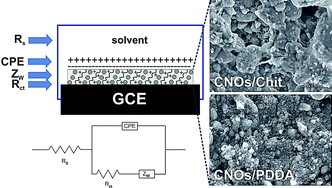Electrochemical properties of composites containing smallcarbon nano-onions and solid polyelectrolytes
Abstract
The preparation and electrochemical properties of a novel type of composite made of small

* Corresponding authors
a
Institute of Chemistry, University of Bialystok, Hurtowa 1, Bialystok, Poland
E-mail:
mplonska@uwb.edu.pl
Fax: +48 85 747 0113
Tel: +48 85 745 7816
b
Department of Chemistry, Clemson University, Clemson, South Carolina, USA
E-mail:
luis@clemson.edu
Fax: +1 864-656-6613
Tel: +1 864-656-0778
The preparation and electrochemical properties of a novel type of composite made of small

 Please wait while we load your content...
Something went wrong. Try again?
Please wait while we load your content...
Something went wrong. Try again?
J. Breczko, K. Winkler, M. E. Plonska-Brzezinska, A. Villalta-Cerdas and L. Echegoyen, J. Mater. Chem., 2010, 20, 7761 DOI: 10.1039/C0JM01213K
To request permission to reproduce material from this article, please go to the Copyright Clearance Center request page.
If you are an author contributing to an RSC publication, you do not need to request permission provided correct acknowledgement is given.
If you are the author of this article, you do not need to request permission to reproduce figures and diagrams provided correct acknowledgement is given. If you want to reproduce the whole article in a third-party publication (excluding your thesis/dissertation for which permission is not required) please go to the Copyright Clearance Center request page.
Read more about how to correctly acknowledge RSC content.
 Fetching data from CrossRef.
Fetching data from CrossRef.
This may take some time to load.
Loading related content
